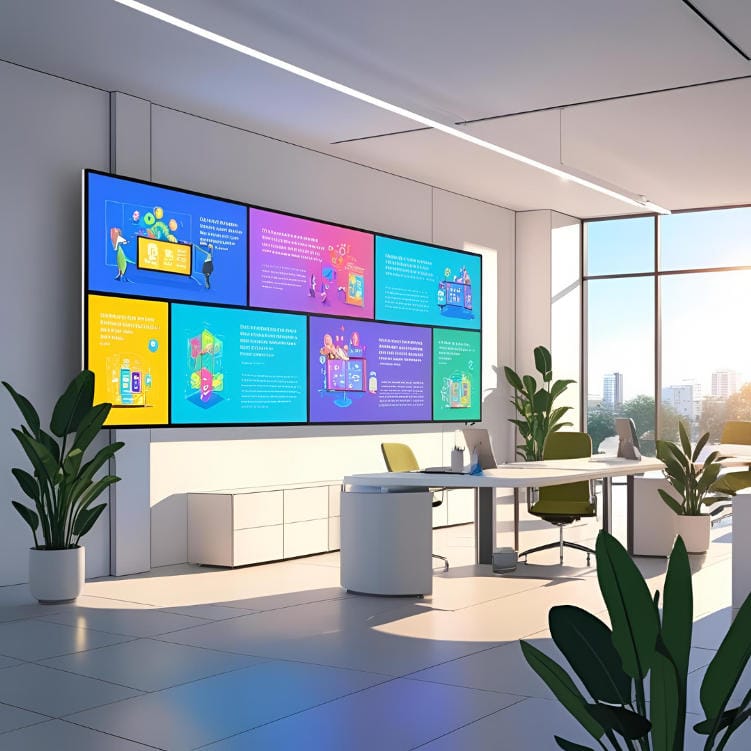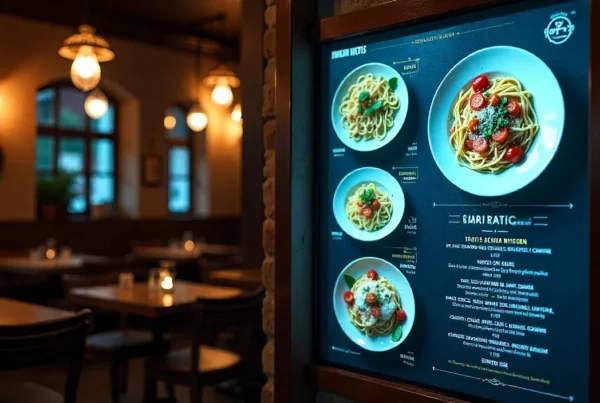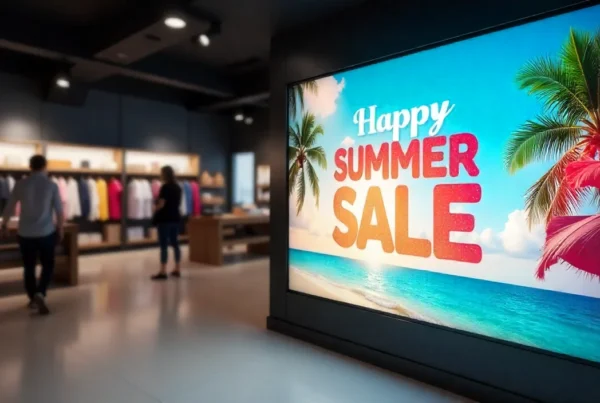Introduction to Restaurant TV Menus
In a digital world, what you offer today understandably has to be close to perfection, with restaurants constantly looking to make efficient use of available resources to provide customers with an improved experience and operational efficiency. A TV for a menu display is one of the most popular solutions. Restaurant TV menus are digital menus on the screen that substitute traditional printed menus and provide businesses with the ability to update content in real time to better engage customers. But do they really work? I want to take a closer look at the effect the restaurant TV menus have and if they are appropriate for your establishment.

Benefits of Using a TV for Restaurant Menu Display
1. Enhanced Customer Experience
Restaurant TV menu display is a highly successful way of showing customers menu items, prices & promotions, without the clutter of traditional signage.
2. Increased Sales and Upselling Opportunities
Digital menus help you to highlight and promote promotions, combos, new dishes, which in turn influences customer choices, and increases revenue.
3. Real-Time Updates and Flexibility
The restaurant TV menu board can be quickly updated which means correct pricing, seasonal specials and quick menu changes.
4. Cost-Effective in the Long Run
Although the initial setup cost might be high, restaurant menu TV does not require frequent reprinting costs, which will save the owner money in the long run.
5. Modern and Attractive Aesthetic
Restaurant TV menu design gives a sleek and contemporary look to the menu which contributes to establishing the brand image and attracting tech savvy customers.
6. Easy Integration with POS and Online Systems
Restaurant menu TV solutions that can integrate with point of sale (POS) systems will automatically update and eliminate the possibility of human errors.

How to Design an Effective Restaurant TV Menu
1. Use High-Quality Images and Videos
Pictures of meals and snacks that are displayed on the menus help in drawing the attention of the consumers as well as influence their choices.
2. Keep Text Readable
The language used should be large enough to be legible and it is advisable not to cram too much information on the screen.
3. Utilize Motion Graphics Wisely
Small animations are good but should not be too active to capture the attention of the customers.
4. Highlight Specials and Bestsellers
Allocate graphical area for daily specials, special offers and most ordered meals.
5. Ensure Brand Consistency
Ensure that you keep the color scheme, fonts used and logo of your restaurant to achieve a professional look.
Choosing the Right TV for Restaurant Menu Display
The selection of a suitable television for your restaurant menu requires careful consideration because it determines both visibility and durability and operational effectiveness. Here’s what to consider:
1. Optimal Screen Size and Placement
Select a screen that provides clear visibility throughout the distance but stays proportionate to your space dimensions. The strategic location of the TV makes it simple for customers to read the menu without straining their eyes.
2. Brightness and High-Resolution Display
The essential requirement for clear menu visibility is a high-resolution TV which includes brightness adjustment capabilities for different lighting environments. The display technology should deliver sharp images which stay clear under both indoor dining room dimness and outdoor counter brightness.
3. Durability and Long-Term Performance
Select a television system made for commercial use to operate continuously throughout the day. The commercial screens maintain their functionality through continuous operation because they resist overheating and screen burn-in effects.
4. Smart Features and Seamless Connectivity
Users can easily manage content updates through Nento Corp. Smart TVs since these devices come with built-in WiFi connectivity and cloud integration features and app support capabilities.
5. Proper Mounting and Easy Accessibility
The TV installation should be done at the right height and angle to maintain visibility but minimize its prominence. Consider how easy it will be to maintain and update content on your digital menu system since these factors influence its operational smoothness.
How to Update and Manage Your Restaurant Menu TV
1. Use a Cloud-Based Digital Signage Solution
The cloud platform Nento Corp enables restaurant managers to handle their menu content through any device while maintaining consistent information at multiple facilities.
2. Schedule Menu Changes
Update your restaurant menu through pre-scheduled changes during peak business periods together with seasonal product offers and restricted-time marketing campaigns. Your menu stays contemporary and attractive which leads to active customer interest and increased sales popularity.
3. Monitor Performance Metrics
Arenas built to track digital menu use by customers will provide vital performance data. Research into which products customers view most often together with which deals achieve better results to create data-backed product changes that raise revenue along with better customer satisfaction levels.

Maximizing Engagement with Your Restaurant TV Menu
A restaurant TV menu display serves more purposes than visual advertising because it creates customer engagement to drive sales and improve dining experiences. To maximize the benefits of a restaurant TV menu display, follow these steps:
1. Leverage High-Quality Visuals
The combination of bright pictures with mouth-watering appeal and brief promotional videos will increase menu item attractiveness. The display should showcase new ready-to-serve dishes together with kitchen production videos featuring the chef or highlights of specialties.
2. Incorporate Social Proof
Display customer endorsements and positive evaluations or social media posts created by users on the menu display in order to establish trust and boost purchase activity. The “Dish of the Day – Loved by Customers” feature rotating display section influences customer preference selection.
3. Promote Online and Loyalty Programs
The restaurant TV menu board should showcase QR codes which allow customers to join loyalty programs and order online and engage with social media. Customers who scan the provided QR codes access special discounts as well as rewards programs.
Case Studies: Restaurants That Succeeded with TV Menu Boards
1. Fast-Casual Chain Boosts Sales by 20%
This burger chain enhanced their sales numbers through menu shift from paper to television screens at restaurants which boosted upsells coupled with combo purchases by 20%.
2. Coffee Shop Increases Order Efficiency
The café combined restaurant TV menu displays with their POS system which cut down customer wait times while optimizing restaurant traffic flow.
3. Family Restaurant Reduces Menu Confusion
When the restaurant displayed timing-sensitive menu changes through digital displays they eliminated many customer complaints about unavailable items.
Common Mistakes to Avoid with Restaurant TV Menus
1. Poor Screen Placement
A restaurant TV menu display loses its effectiveness when it is placed in a location with low visibility. Restaurant screens must be set at a height that matches customer view lines while they face the traffic flow without any hindrances blocking the view. The visibility of the display screen becomes reduced when poor lighting combines with window reflections so consider installing anti-glare technology to enhance readability.
2. Overcrowded Screens
Restaurant customers become disoriented when they face excessive information on TV menu boards. Excessive text as well as multiple fonts and motion effects should be avoided to prevent overwhelming viewers. Your content will become more readable when you keep your categories direct followed by short descriptions with excellent images to improve viewer engagement.
3. Ignoring Updates
The frustration of customers increases when they encounter menus that display incorrect prices or have missing items along with expired promotions. A menu system based on the cloud allows for instant and precise updates. The content must be checked regularly for freshness during scheduled assessments to maintain its relevance.
4. Choosing the Wrong Screen Type
The continuous operation of TVs in high-traffic environments requires specific models which have not been designed for this purpose. The premature failure of cheap consumer TVs results in unnecessary replacement costs because they cannot withstand high-traffic environments. Restaurants should invest in commercial-grade digital displays because these displays provide superior resistance to wear and tear and brighter picture quality and longer operational life.
5. Poor Content Strategy
Restaurant TV menu designs that do not work effectively will lower customer engagement. Tiresome screens which lose audience engagement should be avoided. The menu should display interesting content like limited-time specials and daily deals alongside customer feedback in order to maintain an eye-catching visual display.
Start a 14-Day Free Trial with Nento Corp
The time has come to modernize your restaurant television menu platform. Users can access Nento Corp’s digital signage solution through a free trial period. The system offers simple installation and real-time data updates together with complete menu management system integration.
Start Your 14-Day Free Trial Today!
FAQ: Everything You Need to Know About Restaurant TV Menus
How much does a restaurant TV menu cost?
The overall expense for restaurant TV menu systems depends on hardware and software costs and installation fees between $500 and $5,000.
Can I use any TV for a restaurant menu board?
For optimal results choose restaurant displays made for commercial use which provide extended performance and better visibility.
How do I update my digital menu?
The cloud-based Nento Corp software allows menu updates via any device through its remote functionality.
Do restaurant TV menus increase sales?
Dynamic menus using electronic displays both attract customers and display promotions which leads to additional sales.
What type of content works best on restaurant TV menus?
The best format for digital menu success includes high-resolution images with clear pricing and featured items with limited-time promotional offers.
How can I test if a TV menu board is right for my restaurant?
Customers can begin their free trial of Nento Corp’s digital signage software for 14 days to discover its advantages.





